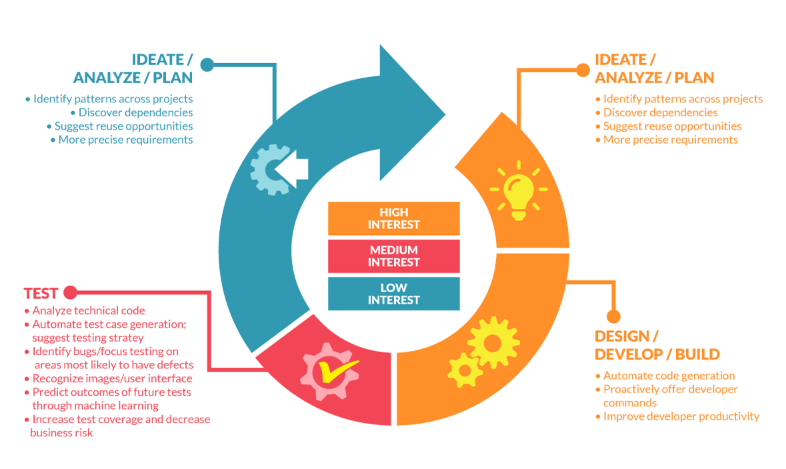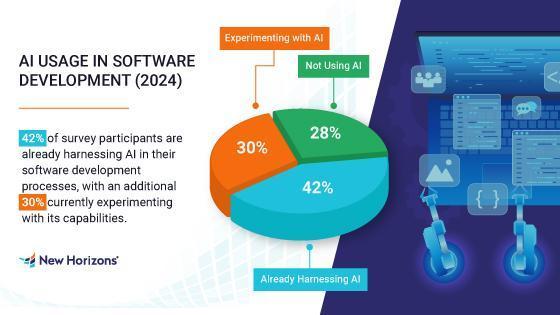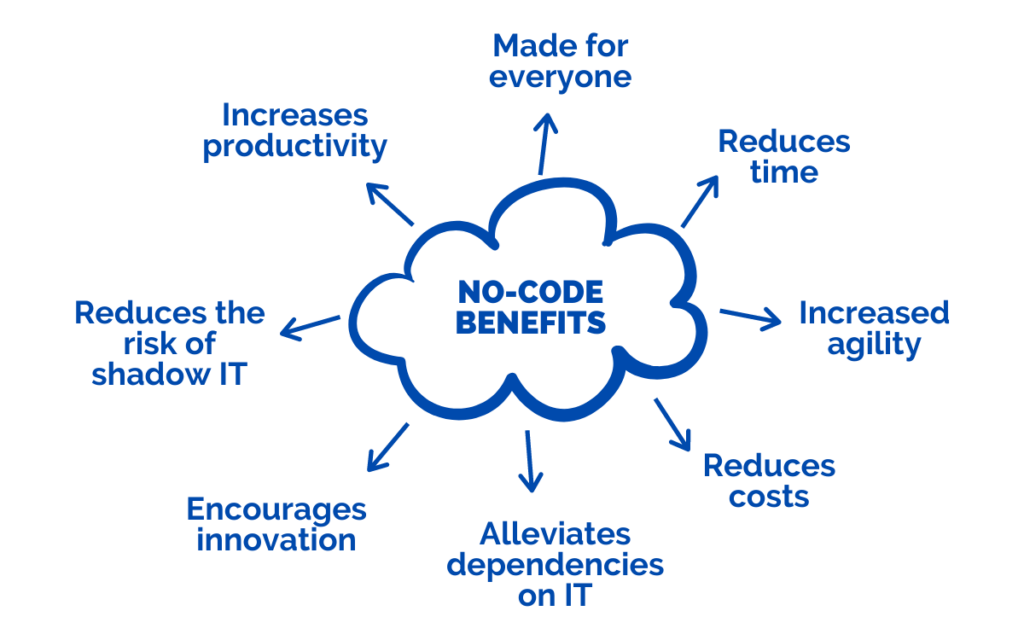We ❤️ Open Source
A community education resource
Your 2025 guide to AI, no-code, and developer-led software
3 trends shaping software development.

Since businesses continue to strive for competition, software development is no longer a must-do but a matter of how to do it. The decision of which software development approach to adopt, from startup optimization to large enterprise digital transformation, can be a make-or-break moment for success or failure.
Three major subjects dominate the conversation: AI-powered development, no-code/low-code platforms, and employing skilled engineers. Each technique has various benefits and considerations, which make decisions less about right or wrong and more about accomplishing specific organizational goals.
Let’s look at how to make an informed decision between these ways while being vendor-neutral and current on trends.
The current landscape of software development
In recent years, the software development environment has undergone a deep transformation. Gartner predicts that by no later than 2026, low-code development tools will be used by 75% of enterprises for their IT application software development. Global market value for AI software will reach $150 billion by the year 2025.
This environment offers flexibility but also introduces some challenges. Now, let’s discuss the advantages of each method in detail.
1) AI-driven development: Software that builds itself
Software engineering has been developing along with the emergence of AI, which is an important driving force for productivity and innovations. Automating code syntax generation, method development, and identification, as well as software bug solving, alternative code structures, etc., by using AI-powered tools such as GitHub Copilot and Tabnine, on the one hand, helps improve the productivity and maintainability of the development process and software development process on the other hand.
A recent Forrester research report polled software engineers about how much interest they had in implementing AI in various areas of software development. As you can see in the graphic below, testing was the highest area of interest.

Why choose AI for software development?
- Speed and efficiency: AI tools can greatly reduce development time. The developers who embedded AI support indicated a speed increase of 30% in coding time with a possibility to better use their resources for more creative and strategic work.
- Cost-effective scaling: AI systems automate repetitive activities, lowering reliance on huge staff. This efficiency allows startups and SMBs with limited funds to scale without incurring balanced cost increases.
- Enhanced accuracy: Modern AI models are intended to reduce errors, uncover security risks, and offer remedies proactively, which results in robust and secure applications.
According to the New Horizons survey, 42% of the respondents are already using AI, and 30% of them are currently experimenting with it.

Read more: Why AI won’t replace developers—And how mastering it will keep you ahead
2) No-code and low-code platforms: empowering everyone
Low-code/no-code platforms facilitate the development of applications quickly and flexibly for companies without prior technological expertise. Popular platforms such as Bubble, OutSystems, and Microsoft PowerApps are opening the doors of app development to anyone to turn ideas into reality.
Why choose no-code/low-code development?
Simplicity and speed: No-code tools are created using drag-and-drop interfaces, ready-made templates, and configurable modules so that by using them, it is possible to develop working applications within hours.
- Cost savings: In a time when development teams of granularity are no longer available, the resource management of companies could be augmented even more. According to Gartner, the business enterprise-developed new applications will be principally driven by low-code/no-code initiatives (70%—more than 2 times the figure of less than 25% for 2023) by 2025.
- Continuous innovation: Iterations on existing apps can be realized more smoothly using no-code platforms. Teams may experiment and arrive at new features without large financial or downtime costs.

A mid-sized logistics company, similar to those operating in North America’s or SE Asia’s large supply chain countries, went digital with a low-code platform in their tracing system. That change allowed them to transfer from ad-hoc spreadsheet logging to real-time shipment tracking, consequently enhancing delivery precision and customer satisfaction.
3) Hiring developers: The classic route
Despite advancements in AI and no-code tools, there will always be a need for skilled developers. Professional development groups can provide the experience, innovation, and unraveling of a process that, no matter how intelligent, will exceed the capacity to be empirically achieved by a mechanism.
Why invest in professional developers?
- Custom solutions: Complex projects often require unique, tailor-made solutions. Hiring developers guarantees that your software meets market needs.
- Future-proofing: Developers can design and build flexible, scalable systems that can grow and meet future demands. However, AI and no-code tools are likely to be limited in scale and in-plug legacy system capability.
- Specialized expertise: In such projects based on new technologies (such as blockchain, AR, VR, and IoT), the technical explanation for the success will be provided by a developer working in such a field.
For example, a global financial institution may place a high priority on complying with international standards in developing a mobile banking application. Using the support of a talented development team, maximum security, the ability to implement durable data encryption, user authentication, and simple integration with extant systems is attainable.
Choosing the right approach: Key factors to consider
Businesses should consider the following factors when deciding between AI, no-code, or professional developers.
- Budget: For simple applications, AI and no-code solutions are more affordable. However, hiring qualified developers could be necessary for intricate, high-stakes projects.
- Project complexity: No-code tools are ideal for MVPs and non-critical applications, and AI can be the middle ground for handling moderate complexity efficiently.
- Scalability needs: Developers create scalable, reliable systems. Limitations may arise with no-code tools as user demand rises.
- Timeline: In applications that have a strict time-to-market, AI and no-code-based platforms provide unrivaled speed.
Trends shaping software development in 2025
Collaborative AI tools: Developer’s new copilot
AI technologies continue to develop at an extraordinary rate and are in a most unexpected position as the creator of the integration of AI in the form of software living at its commercial stock. As it may be shown in principle by 2025, AI-based tools should enable the possibility of predicting the arrival of intelligent co-pilots for testing purposes.
No-code ecosystem expansion
The no-code application development platform has generated a remarkable amount of momentum, enabling non-technical users to build applications. In 2025, this growth will be more widespread through the capabilities of AI situated at the edges of the network, an expanding developer ecosystem, and broad enterprise adoption.
Hybrid models: The best of both worlds
By 2025, a mix of no-code tools and traditional coding will be the go-to approach. It makes testing ideas faster, allows for custom features, and helps teams use their resources wisely. This approach offers several benefits, including rapid prototyping, customizable features, and efficient resource allocation.
Your software, your way
In 2025, businesses will have a wider range of choices for creating software than they do now. Whether you’re experimenting with AI, enjoying the convenience of no-code platforms, or hiring skilled developers, the key is to match your strategy to your objectives, resources, and timeframes.
The future is about integrating skills and creating necessary solutions, not favoring one over another. By examining your individual needs and staying current, you may not only design better software but also help your firm prosper in a tech-driven economy.
So, what is your next step: AI, no-code, or hiring a developer?
More from We Love Open Source
- Comparing GitHub Copilot and Codeium
- How to build a multiagent RAG system with Granite
- Build a local AI co-pilot using IBM Granite Code, Ollama, and Continue
- How AI and decentralized cloud services are shaping the future of open source
- Why AI won’t replace developers—And how mastering it will keep you ahead
The opinions expressed on this website are those of each author, not of the author's employer or All Things Open/We Love Open Source.
